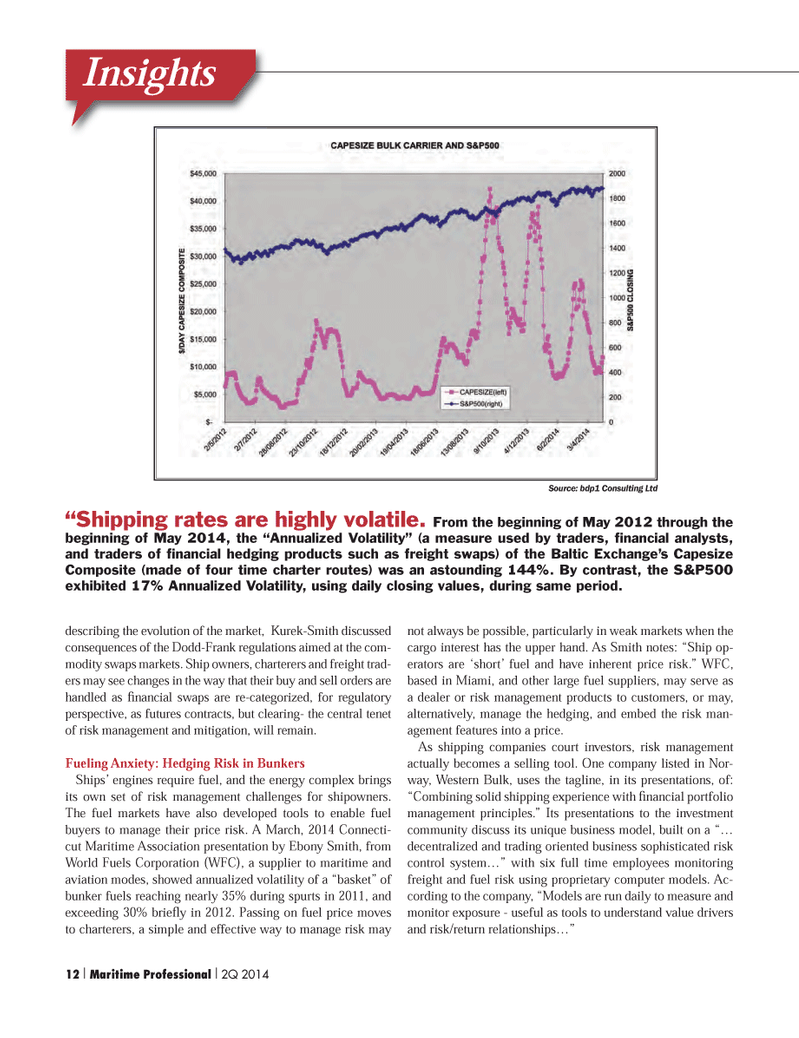
Page 12: of Maritime Logistics Professional Magazine (Q2 2014)
Maritime Risk & Shipping Finance
Read this page in Pdf, Flash or Html5 edition of Q2 2014 Maritime Logistics Professional Magazine
describing the evolution of the market, Kurek-Smith discussed consequences of the Dodd-Frank regulations aimed at the com- modity swaps markets. Ship owners, charterers and freight trad- ers may see changes in the way that their buy and sell orders are handled as fi nancial swaps are re-categorized, for regulatory perspective, as futures contracts, but clearing- the central tenet of risk management and mitigation, will remain.
Fueling Anxiety: Hedging Risk in Bunkers
Ships’ engines require fuel, and the energy complex brings its own set of risk management challenges for shipowners.
The fuel markets have also developed tools to enable fuel buyers to manage their price risk. A March, 2014 Connecti- cut Maritime Association presentation by Ebony Smith, from
World Fuels Corporation (WFC), a supplier to maritime and aviation modes, showed annualized volatility of a “basket” of bunker fuels reaching nearly 35% during spurts in 2011, and exceeding 30% briefl y in 2012. Passing on fuel price moves to charterers, a simple and effective way to manage risk may not always be possible, particularly in weak markets when the cargo interest has the upper hand. As Smith notes: “Ship op- erators are ‘short’ fuel and have inherent price risk.” WFC, based in Miami, and other large fuel suppliers, may serve as a dealer or risk management products to customers, or may, alternatively, manage the hedging, and embed the risk man- agement features into a price.
As shipping companies court investors, risk management actually becomes a selling tool. One company listed in Nor- way, Western Bulk, uses the tagline, in its presentations, of: “Combining solid shipping experience with fi nancial portfolio management principles.” Its presentations to the investment community discuss its unique business model, built on a “… decentralized and trading oriented business sophisticated risk control system…” with six full time employees monitoring freight and fuel risk using proprietary computer models. Ac- cording to the company, “Models are run daily to measure and monitor exposure - useful as tools to understand value drivers and risk/return relationships…”
Insights “Shipping rates are highly volatile. From the beginning of May 2012 through the beginning of May 2014, the “Annualized Volatility” (a measure used by traders, fi nancial analysts, and traders of fi nancial hedging products such as freight swaps) of the Baltic Exchange’s Capesize
Composite (made of four time charter routes) was an astounding 144%. By contrast, the S&P500 exhibited 17% Annualized Volatility, using daily closing values, during same period.
Source: bdp1 Consulting Ltd 12 I Maritime Professional I 2Q 2014 1-17 Q2 MP2014.indd 12 5/16/2014 11:41:19 AM

 11
11

 13
13
